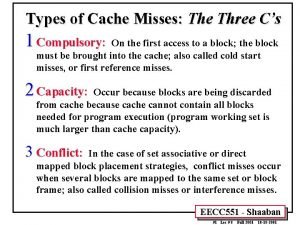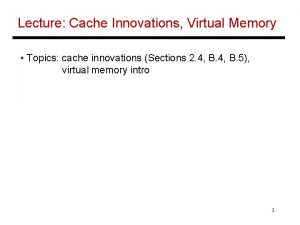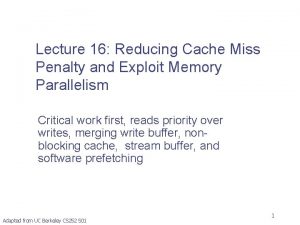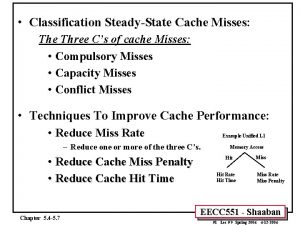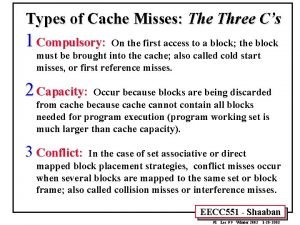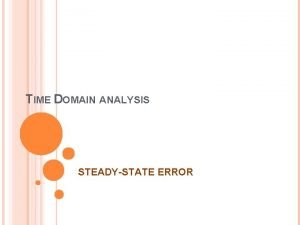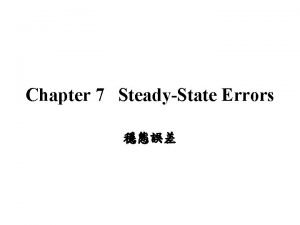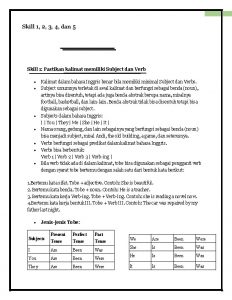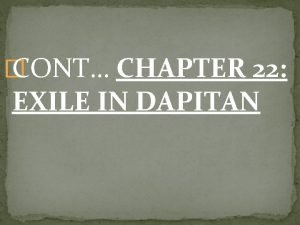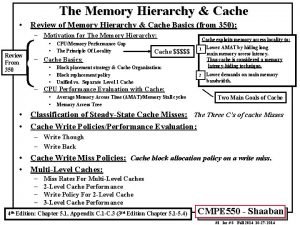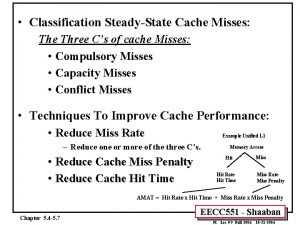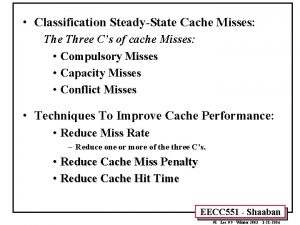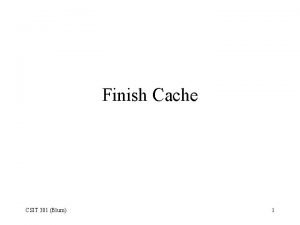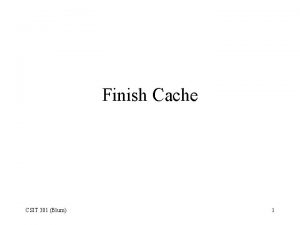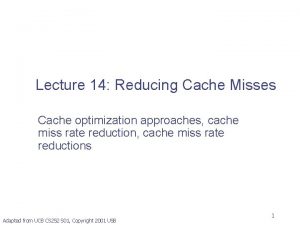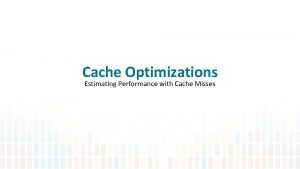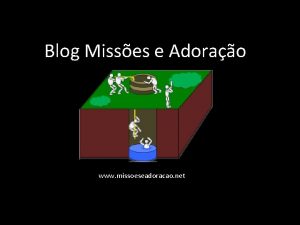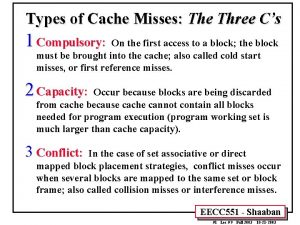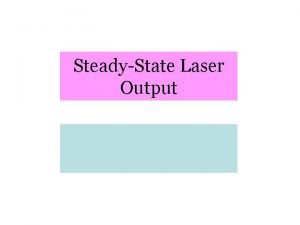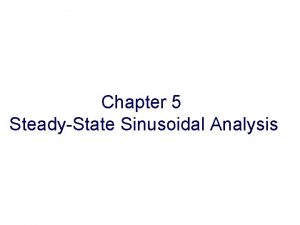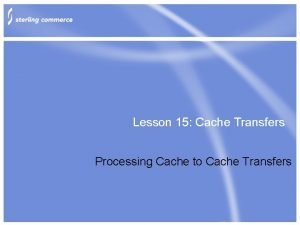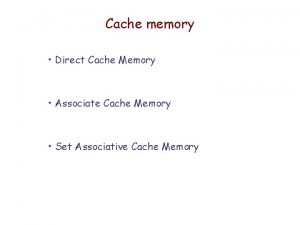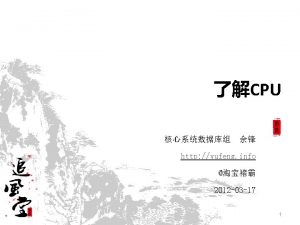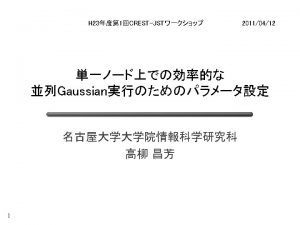Classification SteadyState Cache Misses The Three Cs of

































- Slides: 33

• Classification Steady-State Cache Misses: The Three C’s of cache Misses: • Compulsory Misses • Capacity Misses • Conflict Misses • Techniques To Improve Cache Performance: • Reduce Miss Rate Example Unified L 1 – Reduce one or more of the three C’s. • Reduce Cache Miss Penalty • Reduce Cache Hit Time Chapter 5. 4 -5. 7 Memory Access Hit Miss Hit Rate Hit Time Miss Rate Miss Penalty EECC 551 - Shaaban #1 Lec # 9 Spring 2004 4 -12 -2004

Types of Cache Misses: The Three C’s 1 Compulsory: On the first access to a block; the block must be brought into the cache; also called cold start misses, or first reference misses. 2 Capacity: Occur because blocks are being discarded from cache because cache cannot contain all blocks needed for program execution (program working set is much larger than cache capacity). 3 Conflict: In the case of set associative or direct mapped block placement strategies, conflict misses occur when several blocks are mapped to the same set or block frame; also called collision misses or interference misses. EECC 551 - Shaaban #2 Lec # 9 Spring 2004 4 -12 -2004

The 3 Cs of Cache: Absolute Steady State Miss Rates (SPEC 92) EECC 551 - Shaaban #3 Lec # 9 Spring 2004 4 -12 -2004

The 3 Cs of Cache: Relative Steady State Miss Rates (SPEC 92) 100% 80% Conflict 2 -way 4 -way 8 -way 60% 40% Capacity 20% Cache Size (KB) 128 64 32 16 8 4 2 0% 1 Miss Rate per Type 1 -way Compulsory EECC 551 - Shaaban #4 Lec # 9 Spring 2004 4 -12 -2004

Improving Cache Performance Goal: Reduce AMAT • Lower AMAT implies better cache performance • Example: For single unified level of cache L 1: AMAT = Hit Rate x Hit Time + Miss Rate x Miss Penalty M How? 1 - Miss Rate • Reduce Miss Rate (i. e Increase Hit Rate) • Reduce Cache Miss Penalty • Reduce Cache Hit Time EECC 551 - Shaaban #5 Lec # 9 Spring 2004 4 -12 -2004

Improving Cache Performance • Miss Rate Reduction Techniques: * * Increased cache capacity Higher associativity Hardware prefetching of instructions and data Compiler-controlled prefetching * Larger block size * Victim caches * Pseudo-associative Caches * Compiler optimizations • Cache Miss Penalty Reduction Techniques: * Giving priority to read misses over writes * Early restart and critical word first * Multiple Cache Levels (L 2 , L 3. . ) * Sub-block placement * Non-blocking caches • Cache Hit Time Reduction Techniques: * Small and simple caches * Avoiding address translation during cache indexing * Pipelining writes for fast write hits EECC 551 - Shaaban #6 Lec # 9 Spring 2004 4 -12 -2004

Miss Rate Reduction Techniques: Larger Block Size • A larger block size improves cache performance by taking advantage of spatial locality reducing compulsory misses. • However, for a fixed cache size, larger block sizes mean fewer cache block frames • Performance keeps improving to a limit when the fewer number of cache block frames increases conflict misses and thus overall cache miss rate For SPEC 92 EECC 551 - Shaaban #7 Lec # 9 Spring 2004 4 -12 -2004

Miss Rate Reduction Techniques: Higher Cache Associativity • • A higher degree of associativity reduces miss rates by reducing conflict misses. However, once conflict misses are reduced or eliminated, increasing the degree of associativity will not result in further miss rate reduction and may result in increased clock cycle time (and hit time) due to the additional complexity. Example: Percent miss rates for various cache sizes and degrees of associativity Cache Size (KB) 4 8 16 32 64 128 256 512 1 -way 9. 8 6. 8 4. 9 4. 2 3. 7 2. 1 1. 3 0. 8 Summarized from Figure 5. 14 page 424 Associativity 2 -way 4 -way 7. 6 7. 1 4. 9 4. 4 4. 1 3. 8 3. 7 3. 1 3. 0 1. 9 1. 2 0. 7 0. 6 8 -way 7. 1 4. 4 4. 1 3. 7 2. 9 1. 2 0. 6 In this case most conflict misses are eliminated by 2 -way or 4 -way cache For SPEC 2000 EECC 551 - Shaaban #8 Lec # 9 Spring 2004 4 -12 -2004

Miss Rate Reduction Techniques: Victim Caches • Data discarded from cache is placed in an added small buffer (victim cache). • On a cache miss check victim cache for data before going to main memory • According to Jouppi [1990]: A 4 -entry victim cache removed 20% to 95% of conflict misses for a 4 KB direct mapped data cache • Used in Alpha, HP PA-RISC CPUs. CPU Address =? Tag Address In Out Victim Cache Data Cache =? • Reduces conflict misses • Can also be considered as a miss penalty reduction technique Write Buffer Lower Level Memory EECC 551 - Shaaban #9 Lec # 9 Spring 2004 4 -12 -2004

Miss Rate Reduction Techniques: Pseudo-Associative Cache • • • Attempts to combine the fast hit time of Direct Mapped cache and have the lower conflict misses of 2 -way set-associative cache. Divide cache in two parts: On a cache miss, check other half of cache to see if data is there, if so have a pseudo-hit (slow hit) Easiest way to implement is to invert the most significant bit of the index field to find other block in the “pseudo set”. Hit Time Pseudo Hit Time Reduces Conflict Misses Miss Penalty Time • Drawback: CPU pipelining is hard to implement effectively if L 1 cache hit takes 1 or 2 cycles. – Better used for caches not tied directly to CPU (L 2 cache). – Used in MIPS R 1000 L 2 cache, also similar L 2 in Ultra. SPARC. Similar to Exclusive L 1, L 2 ? EECC 551 - Shaaban #10 Lec # 9 Spring 2004 4 -12 -2004

Miss Rate Reduction Techniques: Hardware Prefetching of Instructions And Data • Prefetch instructions and data before they are needed by the CPU either into cache (into L 2 usually) or into an external prefetching buffer. – Reduces compulsory misses. • Example: The Alpha APX 21064 fetches two blocks on a miss: The requested block into cache and the next consecutive block in an instruction stream buffer. • The same concept is applicable to data accesses using a data buffer. • Extended to use multiple data stream buffers prefetching at different addresses (four streams improve data hit rate by 43%). • It has been shown that, in some cases, eight stream buffers that can handle data or instructions can capture 50 -70% of all misses. EECC 551 - Shaaban #11 Lec # 9 Spring 2004 4 -12 -2004

Miss Rate Reduction Techniques: Compiler Optimizations Compiler cache optimizations improve access locality (spatial and/or temporal) characteristics of the generated code and include: • Reorder procedures in memory to reduce conflict misses. • Merging Arrays: Improve spatial locality by single array of compound elements vs. 2 arrays. • Loop Interchange: Change nesting of loops to access data in the order stored in memory. • Loop Fusion: Combine 2 or more independent loops that have the same looping and some variables overlap. • Blocking: Improve temporal locality by accessing “blocks” of data repeatedly vs. going down whole columns or rows. EECC 551 - Shaaban #12 Lec # 9 Spring 2004 4 -12 -2004

Miss Rate Reduction Techniques: Compiler-Based Cache Optimizations Merging Arrays Example /* Before: 2 sequential arrays */ int val[SIZE]; int key[SIZE]; /* After: 1 array of stuctures */ struct merge { int val; int key; }; struct merged_array[SIZE]; Val array Merged array Key array Val Key Merging the two arrays: – Reduces conflicts between val and key – Improve spatial locality (reduces compulsory misses) EECC 551 - Shaaban #13 Lec # 9 Spring 2004 4 -12 -2004

Miss Rate Reduction Techniques: Compiler-Based Cache Optimizations Loop Interchange Example Assuming row-major matrix memory allocation /* Before */ for (k = 0; k < 100; k = k+1) for (j = 0; j < 100; j = j+1) for (i = 0; i < 5000; i = i+1) x[i][j] = 2 * x[i][j]; /* After */ for (k = 0; k < 100; k = k+1) for (i = 0; i < 5000; i = i+1) for (j = 0; j < 100; j = j+1) x[i][j] = 2 * x[i][j]; Inner loop data access stride: 100 words Current Access 100 words Next Access (from next row) Inner loop sequential data access stride: 1 word Current Access Next Access (from same row) Sequential accesses instead of striding through memory every 100 words in this case improves spatial locality (reduces compulsory misses) EECC 551 - Shaaban #14 Lec # 9 Spring 2004 4 -12 -2004

Miss Rate Reduction Techniques: Compiler-Based Cache Optimizations Loop Fusion Example /* Before */ for (i = 0; i < N; i = i+1) for (j = 0; j < N; j = j+1) a[i][j] = 1/b[i][j] * c[i][j]; for (i = 0; i < N; i = i+1) for (j = 0; j < N; j = j+1) d[i][j] = a[i][j] + c[i][j]; /* After */ for (i = 0; i < N; i = i+1) for (j = 0; j < N; j = j+1) { a[i][j] = 1/b[i][j] * c[i][j]; d[i][j] = a[i][j] + c[i][j]; } Possible Misses Likely hits for a[i][j], c[i][j] (Reduces capacity misses) • Two misses per access to a & c versus one miss per access • Improves spatial and temporal locality. EECC 551 - Shaaban #15 Lec # 9 Spring 2004 4 -12 -2004

Miss Rate Reduction Techniques: Compiler-Based Cache Optimizations Data Access Blocking /* Before No Blocking*/ Example: Matrix Multiplication i < N; i = i+1) j k 0; j < N; j = j+1) i 0; Inner Loop (index k): (k = 0; k < N; k = k+1){ Vector dot product k r = r + y[i][k]*z[k][j]; }; to form a result matrix element x[i][j] = r; x[i][j] }; for (i = 0; for (j = {r = for • Two Inner Loops (to produce row i of X): – Read all Nx. N elements of z[ ] – Read N elements of 1 row of y[ ] repeatedly – Write N elements of 1 row of x[ ] X =Yx Z Matrix Sizes = N x N • Capacity Misses can be represented as a function of N & Cache Size: – Cache size > 3 Nx. Nx 4 => no capacity misses; otherwise. . . • Idea: compute Bx. B submatrix that fits in cache EECC 551 - Shaaban #16 Lec # 9 Spring 2004 4 -12 -2004

Miss Rate Reduction Techniques: Compiler-Based Cache Optimizations Example: Non-Blocked Matrix Multiplication /* Before Blocking*/ for (i = 0; i < 12; i = i+1) for (j = 0; j < 12; j = j+1) {r = 0; for (k = 0; k < 12; k = k+1){ r = r + y[i][k]*z[k][j]; }; x[i][j] = r; }; X =Yx Z N = 12 i. e Matrix Sizes = 12 x 12 Inner Loop: Vector dot product or row i of Y and column j of Z to form a result matrix element x[i][j] j loop j 0 1 2 3 4 5 6 7 8 9 10 11 0 1 2 3 4 i 5 6 7 8 9 10 11 xxxxxxxxxxxx xxxxxxxxxxxx xxxxxxxxxxxx X j 0 1 2 3 4 5 6 7 8 9 10 11 = = 0 1 2 3 4 i 5 6 7 8 9 10 11 yyyyyyyyyyyy yyyyyy y y yky y y yyyyyyyyyyyy yyyyyyyyyyyy Y x x 0 1 2 3 4 i 5 6 7 8 9 10 11 zzzzzzzzzzzz zzzzzz z z z zk z z zzzzzzzzzzzz zzzzzzz Z EECC 551 - Shaaban #17 Lec # 9 Spring 2004 4 -12 -2004

Miss Rate Reduction Techniques: Compiler-Based Cache Optimizations Data Access Blocking (continued) Example: Blocked Matrix Multiplication /* After Blocking */ for (jj = 0; jj < N; jj = jj+B) B for (kk = 0; kk < N; kk = kk+B) for (i = 0; i < N; i = i+1) B for (j = jj; j < min(jj+B, N); j = j+1) {r = 0; for (k = kk; k < min(kk+B, N); k = k+1) { r = r + y[i][k]*z[k][j]; }; X =Yx Z x[i][j] = x[i][j] + r; }; Matrix Sizes = N x N • • B is called the Blocking Factor Blocking improves temporal locality by maximizing access to data while still in cache before it’s replaced (reduces capacity misses) Capacity Misses from 2 N 3 + N 2 (worst case) to 2 N 3/B +N 2 Also improves spatial locality and may also affect conflict misses EECC 551 - Shaaban #18 Lec # 9 Spring 2004 4 -12 -2004

Miss Rate Reduction Techniques: Compiler-Based Cache Optimizations Example: Blocked Matrix Multiplication /* After Blocking*/ for (jj = 0; jj < 12; jj = jj + 4) for (kk = 0; kk < 12; kk = kk + 4) for (i = 0; i < 12; i = i+1) for (j = jj; j < min(jj+4, 12); j = j+1) {r = 0; for (k = kk; k < min(kk+4, 12); k = k+1) { r = r + y[i][k]*z[k][j]; }; x[i][j] = x[i][j] + r; }; j jj 0 1 2 3 4 5 6 7 8 9 10 11 0 1 2 3 4 i 5 6 7 8 9 10 11 xxxxxxxxxxxx xxxxxxxxxxxx xxxxxxxxxxxx X X =Yx Z Matrix Sizes = 12 x 12 Assume Blocking Factor B = 4 jj = 0, 4, 8 kk = 0, 4, 8 j jj 0 1 2 3 4 5 6 7 8 9 10 11 kk j 0 1 2 3 4 5 6 7 8 9 10 11 = = 0 1 2 3 4 i 5 6 7 8 9 10 11 y yk y y yyyyyyyyyyyyy yyyyyyyyyyyy yyyyyyyyyyyy Y x x 0 1 2 3 4 i 5 6 7 8 9 10 11 zzzzzz zk z z zzzzzzzzzzzzz zzzzzzzzzzzz zzzzzzz Z EECC 551 - Shaaban #19 Lec # 9 Spring 2004 4 -12 -2004 kk

Compiler-Based Cache Optimizations (Speedup) EECC 551 - Shaaban #20 Lec # 9 Spring 2004 4 -12 -2004

Miss Penalty Reduction Techniques: Giving Priority To Read Misses Over Writes • Write-through cache with write buffers suffers from RAW conflicts with main memory reads on cache misses: – Write buffer holds updated data needed for the read. – One solution is to simply wait for the write buffer to empty, increasing read miss penalty (in old MIPS 1000 by 50% ). – Check write buffer contents before a read; if no conflicts, let the memory access continue. • For write-back cache, on a read miss replacing dirty block: – Normally: Write dirty block to memory, and then do the read. – Instead copy the dirty block to a write buffer, then do the read, and then do the write. • CPU stalls less (from 2 M down to M) since it restarts soon after the read. EECC 551 - Shaaban #21 Lec # 9 Spring 2004 4 -12 -2004

Miss Penalty Reduction Techniques: Sub-Block Placement • Divide a cache block frame into a number of sub-blocks. • Include a valid bit per sub-block of cache block frame to indicate validity of sub-block. – Originally used to reduce tag storage (fewer block frames). • No need to load a full block on a miss just the needed sub-block. Tag Valid Bits Sub-blocks EECC 551 - Shaaban #22 Lec # 9 Spring 2004 4 -12 -2004

Miss Penalty Reduction Techniques: Early Restart and Critical Word First • Don’t wait for full block to be loaded before restarting CPU: – Early restart: As soon as the requested word of the block arrives, send it to the CPU and let the CPU continue execution. – Critical Word First: Request the missed word first from memory and send it to the CPU as soon as it arrives. • Let the CPU continue execution while filling the rest of the words in the block. • Also called wrapped fetch and requested word first. • Generally useful only for caches with large block sizes. • Programs with a high degree of spatial locality tend to require a number of sequential word, and may not benefit by early restart. EECC 551 - Shaaban #23 Lec # 9 Spring 2004 4 -12 -2004

Miss Penalty Reduction Techniques: Non-Blocking Caches Non-blocking cache or lockup-free cache allows data cache to continue to supply cache hits during the processing of a miss: – Requires an out-of-order execution CPU. – “hit under miss” reduces the effective miss penalty by working during misses vs. ignoring CPU requests. – “hit under multiple miss” or “miss under miss” may further lower the effective miss penalty by overlapping multiple misses. – Significantly increases the complexity of the cache controller as there can be multiple outstanding memory accesses. – Requires multiple memory banks to allow multiple memory access requests. – Example: Intel Pentium III allows up to 4 outstanding memory misses. EECC 551 - Shaaban #24 Lec # 9 Spring 2004 4 -12 -2004

Value of Hit Under Miss For SPEC Average Memory Access Time (A. M. A. T) EECC 551 - Shaaban #25 Lec # 9 Spring 2004 4 -12 -2004

Cache Miss Penalty Reduction Techniques: • Second-Level Cache (L 2) By adding another cache level between the original cache and memory: 1 The first level of cache (L 1) can be small enough to be placed on-chip to match the CPU clock rate. • 2 The second level of cache (L 2) is large enough to capture a large percentage of accesses. When adding a second level of cache: Average memory access time = Hit time. L 1 + Miss rate. L 1 x Miss penalty L 1 where: Miss penalty. L 1 = Hit time. L 2 + Miss rate. L 2 x Miss penalty. L 2 • Local miss rate: the number of misses in the cache divided by the total number of accesses to this cache (i. e Miss rate. L 2 above). • Global miss rate: The number of misses in the cache divided by the total accesses by the CPU (i. e. the global miss rate for the second level cache is Miss rate. L 1 x Miss rate. L 2 Example: Given 1000 memory references 40 misses occurred in L 1 and 20 misses in L 2 The miss rate for L 1 (local or global) = 40/1000 = 4% The global miss rate for L 2 = 20 / 1000 = 2% (Multiple cache levels already covered last Lecture in more detail) EECC 551 - Shaaban #26 Lec # 9 Spring 2004 4 -12 -2004

L 2 Performance Equations AMAT = Hit Time. L 1 + Miss Rate. L 1 x Miss Penalty. L 1 = AMAT = Hit Time. L 2 + Miss Rate. L 2 x Miss Penalty. L 2 Hit Time. L 1 + Miss Rate. L 1 x (Hit Time. L 2 + Miss Rate. L 2 x Miss Penalty. L 2) (Multiple cache levels already covered last Lecture in more detail) EECC 551 - Shaaban #27 Lec # 9 Spring 2004 4 -12 -2004

Cache Miss Penalty Reduction Techniques: 3 Levels of Cache, L 1, L 2, L 3 CPU L 1 Cache L 2 Cache L 3 Cache Hit Rate= H 1, Hit time = 1 cycle Hit Rate= H 2, Hit time = T 2 cycles Hit Rate= H 3, Hit time = T 3 Main Memory access penalty, M (Multiple cache levels already covered last Lecture in more detail) EECC 551 - Shaaban #28 Lec # 9 Spring 2004 4 -12 -2004

L 3 Performance Equations AMAT = Hit Time. L 1 + Miss Rate. L 1 x Miss Penalty. L 1 = Hit Time. L 2 + Miss Rate. L 2 x Miss Penalty. L 2 = AMAT = Hit Time. L 3 + Miss Rate. L 3 x Miss Penalty. L 3 Hit Time. L 1 + Miss Rate. L 1 x (Hit Time. L 2 + Miss Rate. L 2 x (Hit Time. L 3 + Miss Rate. L 3 x Miss Penalty. L 3) (Multiple cache levels already covered last Lecture in more detail) EECC 551 - Shaaban #29 Lec # 9 Spring 2004 4 -12 -2004

Hit Time Reduction Techniques : Tag Check Pipelined Writes Write Tag Check Write • Pipeline tag check and cache update as separate stages; current write tag check & previous write cache update • Only STORES in the pipeline; empty during a miss Store r 2, (r 1) Add -Sub -Store r 4, (r 3) Check r 1 M[r 1]<-r 2& check r 3 • Shaded is “Delayed Write Buffer”; which must be checked on reads; either complete write or read from buffer EECC 551 - Shaaban #30 Lec # 9 Spring 2004 4 -12 -2004

Hit Time Reduction Techniques : Avoiding Address Translation • Send virtual address to cache: Called Virtually Addressed Cache or just Virtual Cache vs. Physical Cache – Every time process is switched logically the cache must be flushed; otherwise it will return false hits • Cost is time to flush + “compulsory” misses from empty cache – Dealing with aliases (sometimes called synonyms); Two different virtual addresses map to same physical address – I/O must interact with cache, so need virtual address • Solution to aliases: – HW guaranteess covers index field & direct mapped, they must be unique; this is called page coloring • Solution to cache flush: – Add process identifier tag that identifies a process as well as address within process: can’t get a hit if wrong process EECC 551 - Shaaban #31 Lec # 9 Spring 2004 4 -12 -2004

Hit Time Reduction Techniques : Virtually Addressed Caches CPU VA Tags PA Tags $ TB PA PA MEM Conventional Organization Virtually Addressed Cache Translate only on miss Synonym Problem TB = Address Translation Buffer PA L 2 $ TB $ $ = Cache $ VA PA VA = Virtual Address PA = Physical Address VA VA VA TB CPU MEM Overlap $ access with VA translation: requires $ index to remain invariant across translation EECC 551 - Shaaban #32 Lec # 9 Spring 2004 4 -12 -2004

Hit time Miss Penalty Miss rate Cache Optimization Summary Technique MR MP Larger Block Size + – Higher Associativity + Victim Caches + Pseudo-Associative Caches + HW Prefetching of Instr/Data Compiler Controlled Prefetching Compiler Reduce Misses + Priority to Read Misses Subblock Placement Early Restart & Critical Word 1 st Non-Blocking Caches Second Level Caches Small & Simple Caches – Avoiding Address Translation Pipelining Writes HT Complexity 0 – 1 2 2 + + 2 3 + + + 0 1 1 2 3 2 0 + 2 1 EECC 551 - Shaaban #33 Lec # 9 Spring 2004 4 -12 -2004
 Types of cache misses
Types of cache misses Techniques for reducing cache misses
Techniques for reducing cache misses Critical word first and early restart
Critical word first and early restart Techniques for reducing cache misses
Techniques for reducing cache misses 3 c's of cache misses
3 c's of cache misses Transfer function steady state error
Transfer function steady state error Steady-state error
Steady-state error The spices flavoring the meal were quite distinctive
The spices flavoring the meal were quite distinctive Near miss event
Near miss event Empathy misses
Empathy misses Fray mariano gil
Fray mariano gil Three level cache organization
Three level cache organization Hình ảnh bộ gõ cơ thể búng tay
Hình ảnh bộ gõ cơ thể búng tay Ng-html
Ng-html Bổ thể
Bổ thể Tỉ lệ cơ thể trẻ em
Tỉ lệ cơ thể trẻ em Chó sói
Chó sói Tư thế worms-breton
Tư thế worms-breton Hát lên người ơi
Hát lên người ơi Các môn thể thao bắt đầu bằng tiếng đua
Các môn thể thao bắt đầu bằng tiếng đua Thế nào là hệ số cao nhất
Thế nào là hệ số cao nhất Các châu lục và đại dương trên thế giới
Các châu lục và đại dương trên thế giới Công của trọng lực
Công của trọng lực Trời xanh đây là của chúng ta thể thơ
Trời xanh đây là của chúng ta thể thơ Mật thư anh em như thể tay chân
Mật thư anh em như thể tay chân 101012 bằng
101012 bằng độ dài liên kết
độ dài liên kết Các châu lục và đại dương trên thế giới
Các châu lục và đại dương trên thế giới Thể thơ truyền thống
Thể thơ truyền thống Quá trình desamine hóa có thể tạo ra
Quá trình desamine hóa có thể tạo ra Một số thể thơ truyền thống
Một số thể thơ truyền thống Bàn tay mà dây bẩn
Bàn tay mà dây bẩn Vẽ hình chiếu vuông góc của vật thể sau
Vẽ hình chiếu vuông góc của vật thể sau Biện pháp chống mỏi cơ
Biện pháp chống mỏi cơ
